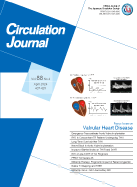88 巻, 4 号
選択された号の論文の30件中1~30を表示しています
- |<
- <
- 1
- >
- >|
Message From the Editor-in-Chief
-
原稿種別: MESSAGE FROM THE EDITOR-IN-CHIEF
2024 年 88 巻 4 号 p. 437-438
発行日: 2024/03/25
公開日: 2024/03/25
[早期公開] 公開日: 2024/03/08PDF形式でダウンロード (348K) HTML形式で全画面表示
Focus on issue: Valvular Heart Disease
Original Articles
TAVR
-
原稿種別: ORIGINAL ARTICLE
専門分野: TAVR
2024 年 88 巻 4 号 p. 439-447
発行日: 2024/03/25
公開日: 2024/03/25
[早期公開] 公開日: 2022/12/27PDF形式でダウンロード (744K) HTML形式で全画面表示 -
原稿種別: EDITORIAL
2024 年 88 巻 4 号 p. 448-450
発行日: 2024/03/25
公開日: 2024/03/25
[早期公開] 公開日: 2023/02/11PDF形式でダウンロード (1756K) HTML形式で全画面表示 -
原稿種別: ORIGINAL ARTICLE
専門分野: TAVR
2024 年 88 巻 4 号 p. 451-459
発行日: 2024/03/25
公開日: 2024/03/25
[早期公開] 公開日: 2023/02/09PDF形式でダウンロード (1483K) HTML形式で全画面表示 -
原稿種別: EDITORIAL
2024 年 88 巻 4 号 p. 460-461
発行日: 2024/03/25
公開日: 2024/03/25
[早期公開] 公開日: 2023/03/16PDF形式でダウンロード (317K) HTML形式で全画面表示 -
原稿種別: ORIGINAL ARTICLE
専門分野: TAVR
2024 年 88 巻 4 号 p. 462-471
発行日: 2024/03/25
公開日: 2024/03/25
[早期公開] 公開日: 2023/11/28PDF形式でダウンロード (2520K) HTML形式で全画面表示 -
原稿種別: EDITORIAL
2024 年 88 巻 4 号 p. 472-474
発行日: 2024/03/25
公開日: 2024/03/25
[早期公開] 公開日: 2023/12/13PDF形式でダウンロード (339K) HTML形式で全画面表示 -
原稿種別: ORIGINAL ARTICLE
専門分野: TAVR
2024 年 88 巻 4 号 p. 475-482
発行日: 2024/03/25
公開日: 2024/03/25
[早期公開] 公開日: 2022/11/18PDF形式でダウンロード (757K) HTML形式で全画面表示 -
原稿種別: ORIGINAL ARTICLE
専門分野: TAVR
2024 年 88 巻 4 号 p. 483-491
発行日: 2024/03/25
公開日: 2024/03/25
[早期公開] 公開日: 2023/10/28PDF形式でダウンロード (1543K) HTML形式で全画面表示 -
原稿種別: ORIGINAL ARTICLE
専門分野: TAVR
2024 年 88 巻 4 号 p. 492-500
発行日: 2024/03/25
公開日: 2024/03/25
[早期公開] 公開日: 2023/08/09PDF形式でダウンロード (1074K) HTML形式で全画面表示 -
原稿種別: ORIGINAL ARTICLE
専門分野: TAVR
2024 年 88 巻 4 号 p. 501-509
発行日: 2024/03/25
公開日: 2024/03/25
[早期公開] 公開日: 2023/10/07PDF形式でダウンロード (1758K) HTML形式で全画面表示
M-TEER
-
原稿種別: ORIGINAL ARTICLE
専門分野: M-TEER
2024 年 88 巻 4 号 p. 510-516
発行日: 2024/03/25
公開日: 2024/03/25
[早期公開] 公開日: 2023/07/13PDF形式でダウンロード (1190K) HTML形式で全画面表示 -
原稿種別: EDITORIAL
2024 年 88 巻 4 号 p. 517-518
発行日: 2024/03/25
公開日: 2024/03/25
[早期公開] 公開日: 2023/08/10PDF形式でダウンロード (1079K) HTML形式で全画面表示 -
原稿種別: ORIGINAL ARTICLE
専門分野: M-TEER
2024 年 88 巻 4 号 p. 519-527
発行日: 2024/03/25
公開日: 2024/03/25
[早期公開] 公開日: 2024/02/08PDF形式でダウンロード (3045K) HTML形式で全画面表示 -
原稿種別: EDITORIAL
2024 年 88 巻 4 号 p. 528-530
発行日: 2024/03/25
公開日: 2024/03/25
[早期公開] 公開日: 2024/03/02PDF形式でダウンロード (821K) HTML形式で全画面表示 -
原稿種別: ORIGINAL ARTICLE
専門分野: M-TEER
2024 年 88 巻 4 号 p. 531-538
発行日: 2024/03/25
公開日: 2024/03/25
[早期公開] 公開日: 2023/11/25PDF形式でダウンロード (1212K) HTML形式で全画面表示 -
原稿種別: ORIGINAL ARTICLE
専門分野: M-TEER
2024 年 88 巻 4 号 p. 539-548
発行日: 2024/03/25
公開日: 2024/03/25
[早期公開] 公開日: 2024/03/06PDF形式でダウンロード (1813K) HTML形式で全画面表示
Surgery
-
原稿種別: ORIGINAL ARTICLE
専門分野: Surgery
2024 年 88 巻 4 号 p. 549-558
発行日: 2024/03/25
公開日: 2024/03/25
[早期公開] 公開日: 2023/01/28PDF形式でダウンロード (1226K) HTML形式で全画面表示 -
原稿種別: ORIGINAL ARTICLE
専門分野: Surgery
2024 年 88 巻 4 号 p. 559-567
発行日: 2024/03/25
公開日: 2024/03/25
[早期公開] 公開日: 2023/04/06PDF形式でダウンロード (1611K) HTML形式で全画面表示 -
原稿種別: ORIGINAL ARTICLE
専門分野: Surgery
2024 年 88 巻 4 号 p. 568-578
発行日: 2024/03/25
公開日: 2024/03/25
[早期公開] 公開日: 2024/01/27PDF形式でダウンロード (1780K) HTML形式で全画面表示 -
原稿種別: ORIGINAL ARTICLE
専門分野: Surgery
2024 年 88 巻 4 号 p. 579-588
発行日: 2024/03/25
公開日: 2024/03/25
[早期公開] 公開日: 2024/01/24PDF形式でダウンロード (1834K) HTML形式で全画面表示 -
原稿種別: ORIGINAL ARTICLE
専門分野: Surgery
2024 年 88 巻 4 号 p. 589-596
発行日: 2024/03/25
公開日: 2024/03/25
[早期公開] 公開日: 2022/10/08PDF形式でダウンロード (1969K) HTML形式で全画面表示
Population Science
-
原稿種別: ORIGINAL ARTICLE
2024 年 88 巻 4 号 p. 597-605
発行日: 2024/03/25
公開日: 2024/03/25
[早期公開] 公開日: 2023/03/01PDF形式でダウンロード (1053K) HTML形式で全画面表示 -
原稿種別: ORIGINAL ARTICLE
専門分野: Population Science
2024 年 88 巻 4 号 p. 606-611
発行日: 2024/03/25
公開日: 2024/03/25
[早期公開] 公開日: 2023/04/11PDF形式でダウンロード (849K) HTML形式で全画面表示
Images in Cardiovascular Medicine
-
原稿種別: IMAGES IN CARDIOVASCULAR MEDICINE
2024 年 88 巻 4 号 p. 612-
発行日: 2024/03/25
公開日: 2024/03/25
[早期公開] 公開日: 2024/01/20PDF形式でダウンロード (669K) HTML形式で全画面表示 -
原稿種別: IMAGES IN CARDIOVASCULAR MEDICINE
2024 年 88 巻 4 号 p. 613-
発行日: 2024/03/25
公開日: 2024/03/25
[早期公開] 公開日: 2024/01/31PDF形式でダウンロード (781K) HTML形式で全画面表示 -
原稿種別: IMAGES IN CARDIOVASCULAR MEDICINE
2024 年 88 巻 4 号 p. 614-
発行日: 2024/03/25
公開日: 2024/03/25
[早期公開] 公開日: 2024/02/21PDF形式でダウンロード (703K) HTML形式で全画面表示
2023 JCS Report
-
原稿種別: 2023 JCS REPORT
2024 年 88 巻 4 号 p. 615-619
発行日: 2024/03/25
公開日: 2024/03/25
[早期公開] 公開日: 2024/03/07PDF形式でダウンロード (2682K) HTML形式で全画面表示
-
2024 年 88 巻 4 号 p. Cover4-
発行日: 2024/03/25
公開日: 2024/03/25
PDF形式でダウンロード (700K) -
2024 年 88 巻 4 号 p. Content4-
発行日: 2024/03/25
公開日: 2024/03/25
PDF形式でダウンロード (821K)
- |<
- <
- 1
- >
- >|
